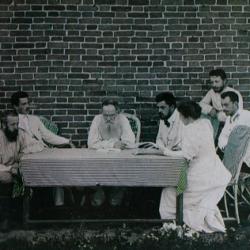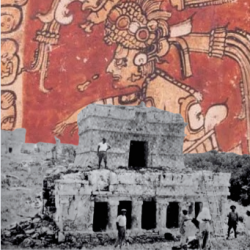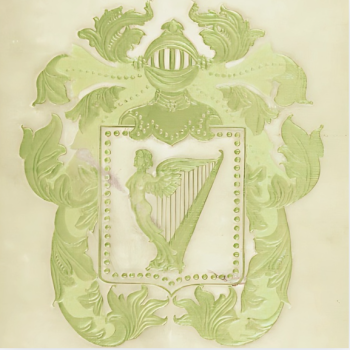MURSHID QULI KHAN
Before the British, the provinces of the Mughal Empire were a dual system of administration under two officers, the Nazim and the Diwan. The Nazim was the Governor, or Viceroy. The Diwan (Finance Minister) was directly subordinate to the Emperor, and independent of the Nazim.[1] Though Bengal was rich and fertile, it brought little into the Imperial exchequer. The revenue of the khálsa (Crown lands) was so small, that it did not cover the expense of the Nazim, nor the salaries of the military and civil establishments. Money had to be remitted from more lucrative provinces to cover the Bengal deficit. Higher officers were averse to service in the province, in no small part, owing to its “evil reputation.” Many believed the region to be fatal to human life, and the “actual haunt of demons.” To persuade officials to settle the Province, large tracts of land were given to them as over to them as jāgirs (military fief.)
In 1697, Prince Azim-ush-Shan became Nazim Bengal, where he had free reign for three years at the Dacca, the capital. In 1701 he was joined by Murshid Quli Khan, who was appointed Diwan of Bengal by Mughal emperor, Aurangzeb. Murshid Quli Khan was by birth a Brahmin, born Surya Narayan Mishra in the Deccan Plateau. He was sold to Haji Shafi, a Mughal nobleman, who changed his name. Haji Shafi raised him like a son, and took him to Persia where he was grafted with “refinement, orderliness and wisdom.” He rose the ranks though merit and skill. Murshid Quli Khan soon brought about a reorganization of the finances of the province. One of his first tasks was restructuring the pyramid system of revenue-collection. At the top of this pyramid, but beneath the Nawabs, were the zemindars, administrators of territory, and not, initially, owners of land (the exception being small private properties within their territory.) They maintained armies, adjudicated criminal cases, enforced the law, and collected the revenues of the country. Some of these zamindars were Rajas, autonomous Hindu princes who survived under Mughal rule; others were revenue farmers and Mughal government officials who transformed their revenue collecting jurisdictions into large hereditary zamindaris under the active patronage of the nizamat. Below the big zamindars there was a much larger class of high-caste smaller gentry who held talaqs (service grants and rent-free lands) who had the proprietary right of revenue collection of certain defined territories. The chain of revenue-collection rights, therefore, went from the zamindari at the top (sadr) down to the village level, where the village heads collected the revenue of the village, and paid it to the lowest grade of revenue collector. Negotiating the prescriptive land rights in a multi-religious land with a hierarchical caste-system was, naturally, produced an intricate, complex, system, with a tendency towards sub-infeudation or sub-letting. To avoid the trouble of collecting revenue from many petty zamindars and taluqdars, Murshid Quli Khan, encouraged the agglomeration of large stretches of territory under big zamindars.[2]
The success of these policies angered Nazim Azim-ush-Shan, who intended to siphon the revenue of Bengal to finance a campaign to place himself on the Mughal throne after the death of Aurangzeb. Azim-ush-Shan hired soldiers to kill Murshid Quli Khan, but the cunning Diwan foiled the plot. Realizing his life was in danger at Dacca, Murshid Quli Khan moved to Makhsusābād, a town at the center of Bengal. Here he set up the headquarters of the Diwani with other public officials. When Aurangzeb learned of the failed assassination attempt of Murshid Quli Khan, he ordered Nazim Azim-ush-Shan to leave Bengal, and take up his residence in Bihar. Aurangzeb then elevated the position of Murshid Quli Khan to Diwan of Bengal, Bihar, and Orissa, as well as Deputy Nazim of Bengal and Orissa. In the absence of Nazim Azim-ush-Shan, Murshid Quli Khan all the power and privilege of the Nazim. His first act was to change the name of Makhsusābād to Murshidabad (The City of Murshid Quli Khan.) In 1717, the Mughal emperor, Jahandar Shah, gave Murshid Quli Khan the title of Zafar Khan and elevated him to Subahdar of Bengal, thus officially making him both nazim and diwan of Bengal. Murshid Quli Khan, however, declared himself the Nawab of Bengal, thus becoming the first independent nawab of the province.[3] Johnston writes:
The Moguls governed through nawabs; as the central power at Delhi began to break up after the death of Aurungzeb, these provincial viceroys established themselves as independent monarchs. It was, in fact, against one of these, the Nawab of Bengal, that Robert Clive fought at Plassey. The first acquisition of territory by the English in India was thus at the expense of the invading Moguls.[4]
In 1793, after the East India Company supplanted the Mughals, they established the Permanent Settlement, an arrangement of land tax which Charles Cornwallis, Governor of Bengal, hoped would generate enough revenue to pay for off existing debt.[5] There were 15 large zamindaris in Bengal when the British assumed control, and they resembled principalities within the state. The framers of the Permanent Settlement erroneously believed that the zemindars of Bengal were landlords who would carry out desired agricultural improvements if properly incentivized. The zemindars, owing to cultural mistranslation, did not meet this expectation.[6] The result was the rise of “absentee zamindars.”[7] British administrators, therefore, came to believe that there were no landlords in India, and that proprietary rights were vested in the state or khudkast raiyats (resident tenants.) The rights of the zemindars were limited, while the rights of the raiyats were increased, first with the Rent Act of 1859, and later with the Bengal Tenancy Act of 1885.[8]
Table Of Contents →
SOURCES
[1] O’Malley, Lewis Sydney Steward. Murshidabad. The Bengal Secretariat Book Depot. Calcutta, India. (1914): 23-24.
[2] Ray, Ratna; Ray, Rajat. “Zamindars and Jotedars: A Study of Rural Politics in Bengal.” Modern Asian Studies. Vol. IX, No. 1 (1975): 81-102.
[3] Sarkar, Jadu Nath. The History Of Bengal Volume II: The Muslim Period, 1200 To 1757. The University of Dacca. Ramna, Dacca. (1948): 397-407.
[4] Johnston, Charles. “A Perspective On India.” The Atlantic Monthly. Vol. CXXXVIII, No. 6. (December 1926): 848-856.
[5] Travers, T.R. “‘The Real Value of the Lands’: The Nawabs, the British and the Land Tax in Eighteenth-Century Bengal.” Modern Asian Studies. Vol. XXXVIII, No. 3 (July 2004): 517-558.
[6] Ray, Ratna; Ray, Rajat. “Zamindars and Jotedars: A Study of Rural Politics in Bengal.” Modern Asian Studies. Vol. IX, No. 1 (1975): 81-102.
[7] Banerjee, Sumanta. “The ‘Beshya’ and the ‘Babu’: Prostitute and Her Clientele in 19th Century Bengal.” Economic and Political Weekly. Vol. XXVIII, No. 45 (November 6, 1993): 2461-2472.
[8] Ray, Ratna; Ray, Rajat. “Zamindars and Jotedars: A Study of Rural Politics in Bengal.” Modern Asian Studies. Vol. IX, No. 1 (1975): 81-102.













